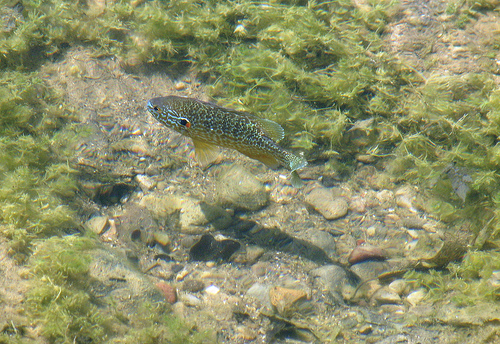Reproduction
The pumpkinseed sunfish, like every other organism on the planet, has a specific way of reproducing. Pumpkinseeds generally begin reproducing in their second year of life. The males and females swim side by side, the females releasing their eggs as the male releases sperm into the water. Females will lay 1,500 to 7,000 eggs, which will hatch in two to three days.
The pumpkinseed sunfish, like many other species of fish (and birds) builds a nest to house the eggs and fry when they hatch. The nest is built by the males by making strong strokes with their tails to clear away silt and rocks. Large objects the pumpkinseed will remove with it's mouth. The nests are usually four to fifteen inches in diameter, and can be found in water six inches deep to several feet deep. The females during this time stay in deeper water and take no part in the construction of the nests. Females will actually share nests with other females, making the fry count in some nests over eight hundred.

After the eggs are laid and the fry are hatched, the males stay and defend the nest while females return back to deeper water. Males will become very defensive (so watch your toes!) when protecting the nest, such as fighting off intruders. One such method that they use is flaring their gills to try and scare off intruders. When fry wander out of the nest, the males will actually leave the nest and bring the individual back to the nest.

Studies were done to show what the effects were of different reproductive habitats. When reproducing in the summer, there was a greater overall density of eggs. Water depths also had an effect on the densities. Nest that were built in shallower water had a greater density of eggs, while those built in deeper water had a smaller density. This could be due to different predators that dwell in deeper water, making it more accessible for them to reach the nests. Different bodies of water have also shown to have differing reproductive habitats of the pumpkinseeds that reside in them. This creates different "histories" for each habitat, and therefore different reproductive challenges.
Compared to their close relatives, the bluegills who nest in large communities, pumpkinseeds tend to nest individually and protect their nests more fiercely.
Back to home page: Web page